Disulfides in Proteins
Between lectures, lab, gym and regular life (yes, I have one of those!), there wasn’t much time to produce creative content for Steemit lately. The fact that I have to hold a presentation on this publication on Friday, together with someone who doesn’t understand English that well made it even worse.
This morning, I started researching for a post on what chemicals in our brain are responsible for our happiness. After an hour, I deleted everything, because I just knew that this post would be incredibly boring. Not because the subject was boring but because I was bored.@suesa
At first, I considered not posting today (as I did yesterday) but then I thought to myself, why not explain some things to you that I’ll have to present on Friday anyway? So, let’s talk about disulfides.
In your body, there are proteins. Proteins are made up out of amino acids, which are made up out of carbon, oxygen, hydrogen, nitrogen and sometimes sulfur. After the amino acids are put together in a long string, the protein needs to be folded in complicated structures, so it can do what it’s supposed to do.
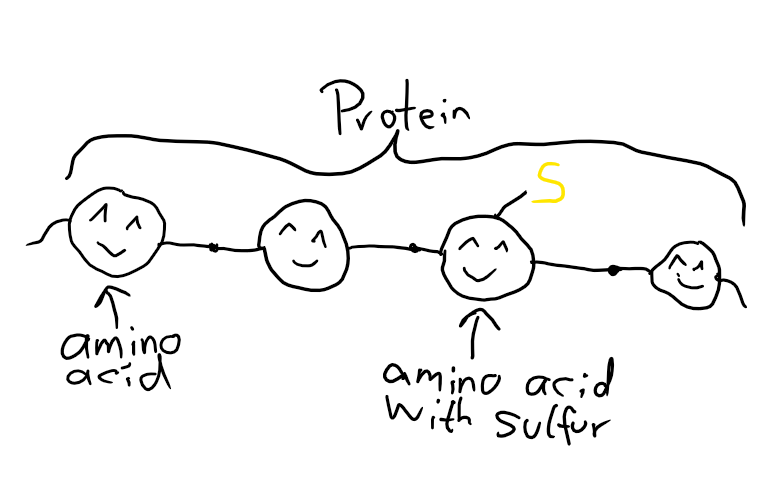
That’s the part where the sulfur comes in. If there are at least two amino acids that contain sulfur (the amino acid in question is called cysteine), the sulfur parts form some sort of “bridge” which folds the protein a certain way.

There are other ways a protein can be folded, but we’ll concentrate on this one because it’s very … extensive.
Connecting the parts doesn’t just happen by itself. It involves 4 Proteins, called DsbA, DsbB, DsbC and DsbD (in E. coli bacteria, that’s what the paper is on, in case you haven’t clicked it. I’m talking about bacteria here. The process of disulfide formation is slightly different in humans). I’ll call them A, B, C and D (Dsb stands for disulfide bond, DsbA means disulfide bond protein A).
It happens like this:
The protein encounters A and gives it an electron, which causes a sulfur of A to connect to a sulfur of the protein. Another protein sulfur gives an electron to A, which leads to the release of A from the complex and forms a bridge between the two sulfurs inside the protein.
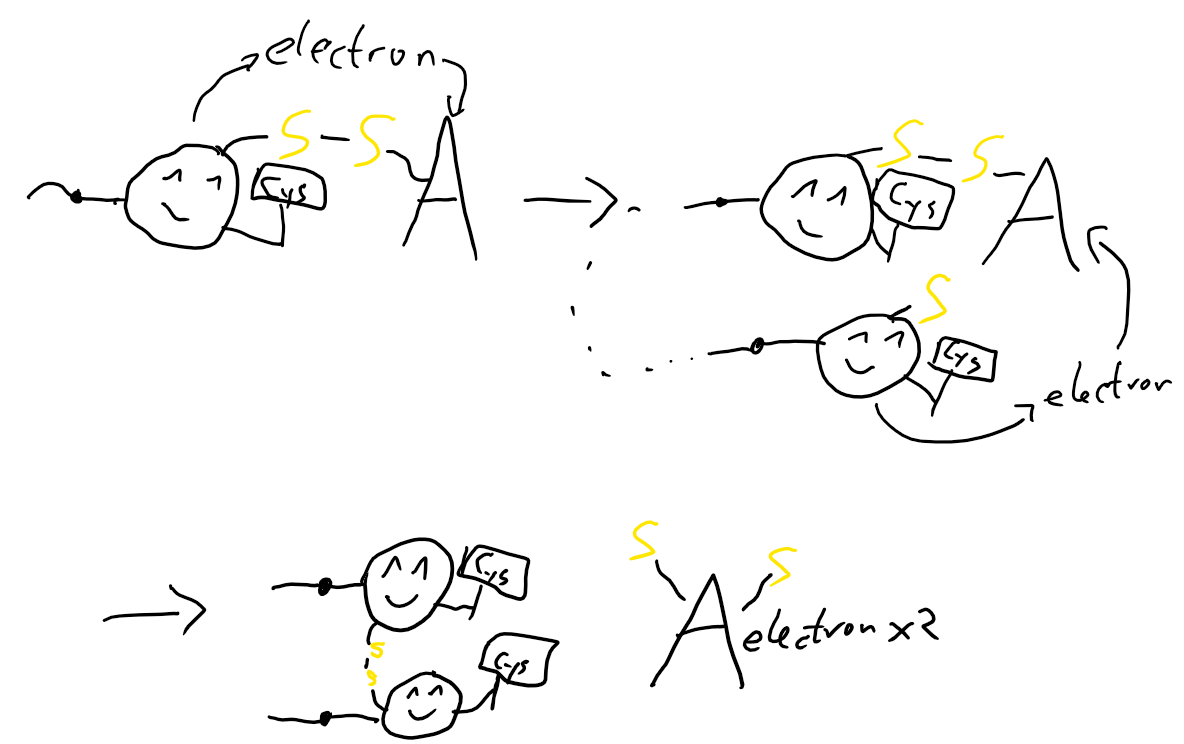
This process is an oxidation-reduction reaction, where A gets reduced and the protein is oxidized. Reduction is the gain of electrons, while oxidation is the loss. I’ll be using these two words from now on!
The protein is oxidized now and the disulfide is formed. But there’s a problem now: A needs to be in an oxidized form to function, but it’s reduced now! That’s where B enters the stage.
B takes away the electrons from A (oxidizes it) and then moves them to a molecule called ubiquinone, which has several jobs inside the cell. Here, it just transfers the electrons, until they end up being transferred to oxygen (if there is air available) or to nitrate (if there isn’t). Both A and B are now in the form they’re supposed to be and can get back to work! Yay!
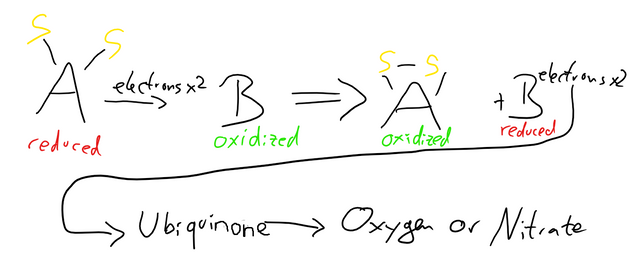
But wait, something is wrong, I told you that there are four proteins at work, we only discussed two so far!
This is because A doesn’t always do a good job. You see, A is only good at connecting two sulfurs that are next to each other, but sometimes, you need to skip one to get the proper form. When A tries to do that, it fails.
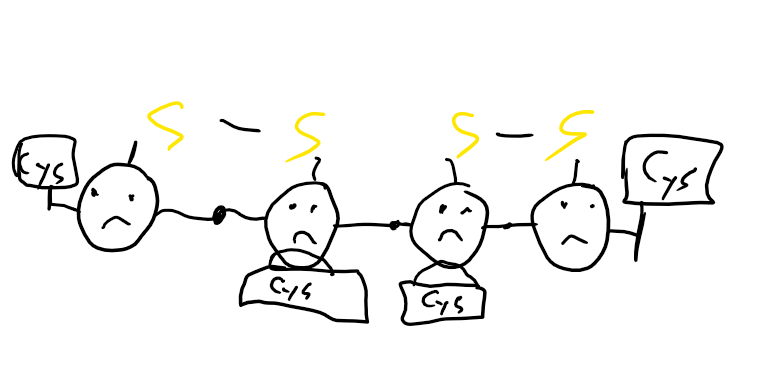
For that, we have C. C can open the bridge up and form a new one. It can also just break the bridge apart without forming a new connection. If the second version happens, it’s effectively reducing the protein and gets oxidized in the process.
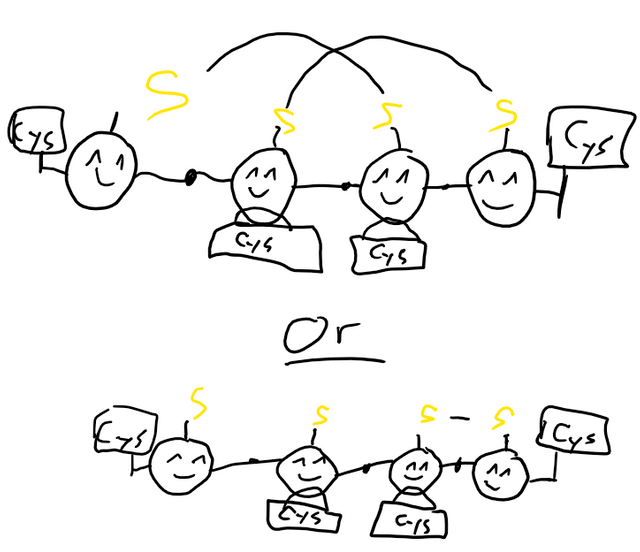
But it needs to be reduced to work. So, again, we have something to help: The protein D.
D does a lot of things. It moves around electrons throughout the cells in ways that aren’t fully understood yet. What is understood is, that it gives electrons to C, to return it to its reduced state. And everyone is happy again.
Of course, there is a lot more behind the mechanisms than I explained. The 3D-structures of the proteins A, B, C, and D are complex and, in the case of D, not yet fully discovered. But I thought it might be interesting for you to learn something that not everyone can find out via a simple google search.
Isn’t that what makes Steemit special? You can learn stuff you never even thought about.
As @thi-js hit 1000 SP now, I’m adopting a new minnow! His name is @emilclaudell and I will vote him until he reaches 1k SP.
Pictures are all made by my incredibly artistic self. I finally got a tablet which allows me to draw on!
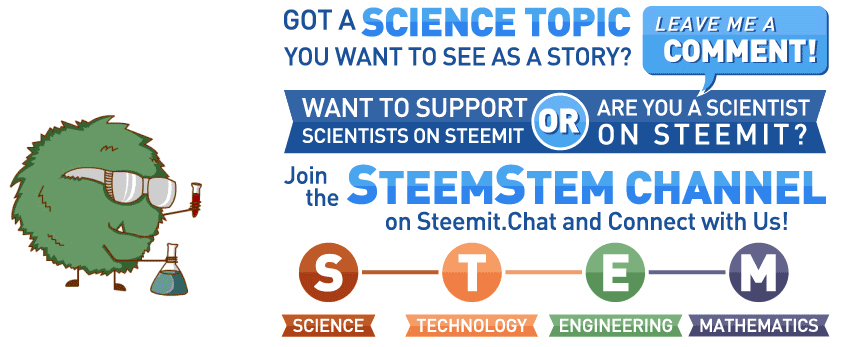
Hello @suesa
I couldn't help but chuckle at your sketches all the way through. I regularly workout at the gym and have some basic knowledge of protein and amino acids. Was nice to get a more technical break down of how they function.
Question/Suggestion: I guess protein supplements like whey, specifically the "Gold" brand work in a similar fashion when consumed? If not I think it would be an interesting post to read. :)
Protein supplements just provide you with amino acids that you need (and sometimes can't produce yourself). No relation to disulfides. You eat the protein, it's broken down in amino acids and those are used to form new proteins :)
Yep, sounds about right. Thanks for the clarification :)
Welcome to Steem, remember me when you are rich :]
You know about it,, I personally never been to Gym and I dont know anything at all about Protein or amino acids.
But Seriously have huge muscles just like a Champion.
.
.
.
I am just kidding: No gym= No muscles looool
Haha, maybe one day? ;)
"No gym = No muscles"
Have you ever seen a black person?
hey @xodan,
I recently wrote a post about collagen supplements, which is also a protein, and general protein supps will be a topic of mine in the next 2-3 weaks.
Let me tell you a spoiler: If you take up enough proteins via your regular nutrition, there is absolutely no need to take supplements - not even if you want to gain muscle mass.
Queen of science... Your sketches prove that art ain't your strength! :D
Thank you for breaking down proteins for us. Question; Was recently told by a doctor that my body or blood (not sure) is full of proteins so I should reduce them. What does that mean? Are they harmful? He said they are.
Vote for best pun 2018
Hey, my drawings are magnificent, ok? :P
I'm not sure what your doctor might have meant by that. Technically, your blood is full of proteins. But it's possible that there are elevated levels of the wrong proteins, or byproducts of protein breakdown. Can't say much about it from afar.
Lol. Okay :p
I am thinking elevated levels of 'wrong' proteins because he suggested I stop consuming them for a while.
Education trough fun - that's what I like :)
Thanks!
Where were you when I was reading this for exams :P
Probably writing about something else... :D
I was dusting up an old poem about DNA, when I read this, so now it doesn't seem so nerdy to post it
I'm happy that you stated that regular steemians do have a life and not just some 1s and 0s in an algorithm :)
Reduction and oxidation or redox reactions are one of my high points in high school classes. Happy to be reminded of some of my high school biology/chemistry classes.
I'm just trying to hide the fact that I'm actually a very sophisticated bot
We love a bot with a human touch :)
boops your nose
Human touch :P
Even Sophie could relate :)
As I have to do another f*cking Western Blot tomorrow, I'm momentarily more interrested in cracking disulfide bonds that building them.^^
But nice sketches ;-)
Break them open!
Western Blots suck so hard, I'm so sorry
ty for your sympathy, I am used to it anyway...
I like your art style. You struggle with handwriting tho.
I could lie and say that my handwriting is only so bad because I'm not used to drawing on a tablet but... I mean, my handwriting is better on paper, but still pretty bad.
I assume the reason is that I only wrote cursive until I was 14 and then forced myself to switch. Never really developed the "typically pretty" handwriting most girls have xD
Lol. What a coincidence, we happen to be studying about protein and its functions relating to its 3D structures. Even learnt the disulfide bond is a more stronger bond as compared to the hydrophobic bond, vander waal's forces etc. As to why protein A doea not do a good job in connecting. It is because protein are specific as to what substrates they bind to. "Structural complementarity"
I enjoy visiting your blog, though this is not my field of study, but when ever I discuss what I have learnt from your blog with my best friend who is a nurse she always marvel at where I get my knowledge from. Thanks @suesa for always sharing. And oh please the post on what chemical in the brain makes us happy ain't going to be boring as a matter of fact, I am already anticipating it